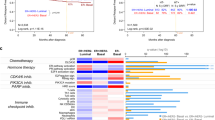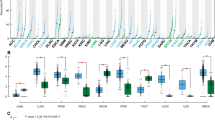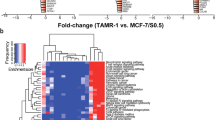Abstract
To elucidate the molecular mechanisms of tamoxifen resistance in breast cancer, we performed gene array analyses and identified 366 genes with altered expression in four unique tamoxifen-resistant (TamR) cell lines vs the parental tamoxifen-sensitive MCF-7/S0.5 cell line. Most of these genes were functionally linked to cell proliferation, death and control of gene expression, and include FYN, PRKCA, ITPR1, DPYD, DACH1, LYN, GBP1 and PRLR. Treatment with FYN-specific small interfering RNA or a SRC family kinase inhibitor reduced cell growth of TamR cell lines while exerting no significant effect on MCF-7/S0.5 cells. Moreover, overexpression of FYN in parental tamoxifen-sensitive MCF-7/S0.5 cells resulted in reduced sensitivity to tamoxifen treatment, whereas knockdown of FYN in the FYN-overexpressing MCF-7/S0.5 cells restored sensitivity to tamoxifen, demonstrating growth- and survival-promoting function of FYN in MCF-7 cells. FYN knockdown in TamR cells led to reduced phosphorylation of 14-3-3 and Cdc25A, suggesting that FYN, by activation of important cell cycle-associated proteins, may overcome the anti-proliferative effects of tamoxifen. Evaluation of the subcellular localization of FYN in primary breast tumors from two cohorts of endocrine-treated ER+ breast cancer patients, one with advanced disease (N=47) and the other with early disease (N=76), showed that in the former, plasma membrane-associated FYN expression strongly correlated with longer progression-free survival (P<0.0002). Similarly, in early breast cancer patients, membrane-associated expression of FYN in the primary breast tumor was significantly associated with increased metastasis-free (P<0.04) and overall (P<0.004) survival independent of tumor size, grade or lymph node status. Our results indicate that FYN has an important role in tamoxifen resistance, and its subcellular localization in breast tumor cells may be an important novel biomarker of response to endocrine therapy in breast cancer.
This is a preview of subscription content, access via your institution
Access options
Subscribe to this journal
Receive 50 print issues and online access
$259.00 per year
only $5.18 per issue
Buy this article
- Purchase on Springer Link
- Instant access to full article PDF
Prices may be subject to local taxes which are calculated during checkout






Similar content being viewed by others
Change history
21 September 2018
Since the online publication of the above article, the authors have noted errors in subfigures 1c and 3b. Therefore, new images of the original immmunocytochemistry stainings have been obtained for Fig. 1c, and the Western blots for siRNA-mediated FYN knockdown in Fig. 3b were repeated. The amended versions of Figs. 1c and 3b are now provided.
References
Osborne CK . Drug therapy—tamoxifen in the treatment of breast cancer. N Engl J Med 1998; 339: 1609–1618.
Davies C, Godwin J, Gray R, Clarke M, Cutter D, Darby S et al. Relevance of breast cancer hormone receptors and other factors to the efficacy of adjuvant tamoxifen: patient-level meta-analysis of randomised trials. Lancet 2011; 378: 771–784.
Mouridsen HT, Robert NJ . Benefit with aromatase inhibitors in the adjuvant setting for postmenopausal women with breast cancer. MedGenMed 2005; 7: 20.
Mouridsen H, Keshaviah A, Coates AS, Rabaglio M, Castiglione-Gertsch M, Sun Z et al. Cardiovascular adverse events during adjuvant endocrine therapy for early breast cancer using letrozole or tamoxifen: safety analysis of BIG 1-98 trial. J Clin Oncol 2007; 25: 5715–5722.
Osborne CK, Schiff R . Mechanisms of endocrine resistance in breast cancer. Annu Rev Med 2011; 62: 233–247.
Schiff R, Massarweh SA, Shou J, Bharwani L, Mohsin SK, Osborne CK . Cross-talk between estrogen receptor and growth factor pathways as a molecular target for overcoming endocrine resistance. Clin Cancer Res 2004; 10: 331S–336S.
Shou J, Massarweh S, Osborne CK, Wakeling AE, Ali S, Weiss H et al. Mechanisms of tamoxifen resistance: increased estrogen receptor-HER2/neu cross-talk in ER/HER2-positive breast cancer. J Natl Cancer Inst 2004; 96: 926–935.
Sun M, Paciga JE, Feldman RI, Yuan Z, Coppola D, Lu YY et al. Phosphatidylinositol-3-OH Kinase (PI3K)/AKT2, activated in breast cancer, regulates and is induced by estrogen receptor alpha (ERalpha) via interaction between ERalpha and PI3K. Cancer Res 2001; 61: 5985–5991.
Pancholi S, Lykkesfeldt AE, Hilmi C, Banerjee S, Leary A, Drury S et al. ERBB2 influences the subcellular localization of the estrogen receptor in tamoxifen-resistant MCF-7 cells leading to the activation of AKT and RPS6KA2. Endocr Relat Cancer 2008; 15: 985–1002.
Gutierrez MC, Detre S, Johnston S, Mohsin SK, Shou J, Allred DC et al. Molecular changes in tamoxifen-resistant breast cancer: relationship between estrogen receptor, HER-2, and p38 mitogen-activated protein kinase. J Clin Oncol 2005; 23: 2469–2476.
Hiscox S, Morgan L, Green TP, Barrow D, Gee J, Nicholson RI . Elevated Src activity promotes cellular invasion and motility in tamoxifen resistant breast cancer cells. Breast Cancer Res Treat 2006; 97: 263–274.
Jordan NJ, Gee JM, Barrow D, Wakeling AE, Nicholson RI . Increased constitutive activity of PKB/Akt in tamoxifen resistant breast cancer MCF-7 cells. Breast Cancer Res Treat 2004; 87: 167–180.
Frogne T, Jepsen JS, Larsen SS, Fog CK, Brockdorff BL, Lykkesfeldt AE . Antiestrogen-resistant human breast cancer cells require activated protein kinase B/Akt for growth. Endocr Relat Cancer 2005; 12: 599–614.
Bunone G, Briand PA, Miksicek RJ, Picard D . Activation of the unliganded estrogen receptor by EGF involves the MAP kinase pathway and direct phosphorylation. EMBO J 1996; 15: 2174–2183.
Nehra R, Riggins RB, Shajahan AN, Zwart A, Crawford AC, Clarke R . BCL2 and CASP8 regulation by NF-kappaB differentially affect mitochondrial function and cell fate in antiestrogen-sensitive and -resistant breast cancer cells. FASEB J 2010; 24: 2040–2055.
Yde CW, Emdal KB, Guerra B, Lykkesfeldt AE . NFkappaB signaling is important for growth of antiestrogen resistant breast cancer cells. Breast Cancer Res Treat 2012; 135: 67–78.
Briand P, Lykkesfeldt AE . Effect of estrogen and antiestrogen on the human breast cancer cell line MCF-7 adapted to growth at low serum concentration. Cancer Res 1984; 44: 1114–1119.
Lykkesfeldt AE, Madsen MW, Briand P . Altered expression of estrogen-regulated genes in a tamoxifen-resistant and ICI 164 384 and ICI 182 780 sensitive human breast cancer cell line, MCF-7/TAMR-1. Cancer Res 1994; 54: 1587–1595.
Madsen MW, Reiter BE, Larsen SS, Briand P, Lykkesfeldt AE . Estrogen receptor messenger RNA splice variants are not involved in antiestrogen resistance in sublines of MCF-7 human breast cancer cells. Cancer Res 1997; 57: 585–589.
Johnston SR, Saccani-Jotti G, Smith IE, Salter J, Newby J, Coppen M et al. Changes in estrogen receptor, progesterone receptor, and pS2 expression in tamoxifen-resistant human breast cancer. Cancer Res 1995; 55: 3331–3338.
Tang S, Han H, Bajic VB . ERGDB: Estrogen Responsive Genes Database. Nucleic Acids Res 2004; 32: D533–D536.
Schrecengost RS, Riggins RB, Thomas KS, Guerrero MS, Bouton AH . Breast cancer antiestrogen resistance-3 expression regulates breast cancer cell migration through promotion of p130Cas membrane localization and membrane ruffling. Cancer Res 2007; 67: 6174–6182.
Masri S, Phung S, Wang X, Wu X, Yuan YC, Wagman L et al. Genome-wide analysis of aromatase inhibitor-resistant, tamoxifen-resistant, and long-term estrogen-deprived cells reveals a role for estrogen receptor. Cancer Res 2008; 68: 4910–4918.
Bilal E, Alexe G, Yao M, Cong L, Kulkarni A, Ginjala V et al. Identification of the YES1 Kinase as a Therapeutic Target in Basal-Like Breast Cancers. Genes Cancer 2010; 1: 1063–1073.
Frankel LB, Lykkesfeldt AE, Hansen JB, Stenvang J . Protein kinase C alpha is a marker for antiestrogen resistance and is involved in the growth of tamoxifen resistant human breast cancer cells. Breast Cancer Res Treat 2007; 104: 165–179.
Frogne T, Laenkholm AV, Lyng MB, Henriksen KL, Lykkesfeldt AE . Determination of HER2 phosphorylation at tyrosine 1221/1222 improves prediction of poor survival for breast cancer patients with hormone receptor-positive tumors. Breast Cancer Res 2009; 11: R11.
Browne BC, Hochgrafe F, Wu J, Millar EK, Barraclough J, Stone A et al. Global characterization of signalling networks associated with tamoxifen resistance in breast cancer. FEBS J 2013; 280: 5237–5257.
Musgrove EA, Sutherland RL . Biological determinants of endocrine resistance in breast cancer. Nat Rev Cancer 2009; 9: 631–643.
Giuliano M, Schifp R, Osborne CK, Trivedi MV . Biological mechanisms and clinical implications of endocrine resistance in breast cancer. Breast 2011; 20: S42–S49.
Rasmussen BB, Regan MM, Lykkesfeldt AE, Dell'Orto P, Del Curto B, Henriksen KL et al. Adjuvant letrozole versus tamoxifen according to centrally-assessed ERBB2 status for postmenopausal women with endocrine-responsive early breast cancer: supplementary results from the BIG 1-98 randomised trial. Lancet Oncol 2008; 9: 23–28.
Gallardo A, Lerma E, Escuin D, Tibau A, Munoz J, Ojeda B et al. Increased signalling of EGFR and IGF1R, and deregulation of PTEN/PI3K/Akt pathway are related with trastuzumab resistance in HER2 breast carcinomas. Br J Cancer 2012; 106: 1367–1373.
Fox EM, Miller TW, Balko JM, Kuba MG, Sanchez V, Smith RA et al. A kinome-wide screen identifies the insulin/IGF-I receptor pathway as a mechanism of escape from hormone dependence in breast cancer. Cancer Res 2011; 71: 6773–6784.
Assender JW, Gee JM, Lewis I, Ellis IO, Robertson JF, Nicholson RI . Protein kinase C isoform expression as a predictor of disease outcome on endocrine therapy in breast cancer. J Clin Pathol 2007; 60: 1216–1221.
Ali HR, Dawson SJ, Blows FM, Provenzano E, Pharoah PD, Caldas C . Cancer stem cell markers in breast cancer: pathological, clinical and prognostic significance. Breast Cancer Res 2011; 13: R118.
van Agthoven T, van Agthoven TL, Portengen H, Foekens JA, Dorssers LC . Ectopic expression of epidermal growth factor receptors induces hormone independence in ZR-75-1 human breast cancer cells. Cancer Res 1992; 52: 5082–5088.
Benz CC, Scott GK, Sarup JC, Johnson RM, Tripathy D, Coronado E et al. Estrogen-dependent, tamoxifen-resistant tumorigenic growth of MCF-7 cells transfected with HER2/neu. Breast Cancer Res Treat 1992; 24: 85–95.
Thrane S, Lykkesfeldt AE, Larsen MS, Sorensen BS, Yde CW . Estrogen receptor alpha is the major driving factor for growth in tamoxifen-resistant breast cancer and supported by HER/ERK signaling. Breast Cancer Res Treat 2013; 139: 71–80.
Boggon TJ, Eck MJ . Structure and regulation of Src family kinases. Oncogene 2004; 23: 7918–7927.
Ito Y, Kawakatsu H, Takeda T, Tani N, Kawaguchi N, Noguchi S et al. Activation of c-Src is inversely correlated with biological aggressiveness of breast carcinoma. Breast Cancer Res Treat 2002; 76: 261–267.
Morgan L, Gee J, Pumford S, Farrow L, Finlay P, Robertson J et al. Elevated Src kinase activity attenuates Tamoxifen response in vitro and is associated with poor prognosis clinically. Cancer Biol Ther 2009; 8: 1550–1558.
Campbell EJ, McDuff E, Tatarov O, Tovey S, Brunton V, Cooke TG et al. Phosphorylated c-Src in the nucleus is associated with improved patient outcome in ER-positive breast cancer. Br J Cancer 2008; 99: 1769–1774.
Mayer EL, Krop IE . Advances in targeting SRC in the treatment of breast cancer and other solid malignancies. Clin Cancer Res 2010; 16: 3526–3532.
Saito YD, Jensen AR, Salgia R, Posadas EM . Fyn: a novel molecular target in cancer. Cancer 2010; 116: 1629–1637.
Frasor J, Chang EC, Komm B, Lin CY, Vega VB, Liu ET et al. Gene expression preferentially regulated by tamoxifen in breast cancer cells and correlations with clinical outcome. Cancer Res 2006; 66: 7334–7340.
Bertero T, Gastaldi C, Bourget-Ponzio I, Mari B, Meneguzzi G, Barbry P et al. CDC25A targeting by miR-483-3p decreases CCND-CDK4/6 assembly and contributes to cell cycle arrest. Cell Death Differ 2013; 20: 800–811.
Xu X, Yamamoto H, Sakon M, Yasui M, Ngan CY, Fukunaga H et al. Overexpression of CDC25A phosphatase is associated with hypergrowth activity and poor prognosis of human hepatocellular carcinomas. Clin Cancer Res 2003; 9: 1764–1772.
Buss JE, Kamps MP, Gould K, Sefton BM . The absence of myristic acid decreases membrane-binding of P60src but does not affect tyrosine protein-kinase activity. J Virol 1986; 58: 468–474.
Elsberger B, Paravasthu DM, Tovey SM, Edwards J . Shorter disease-specific survival of ER-positive breast cancer patients with high cytoplasmic Src kinase expression after tamoxifen treatment. J Cancer Res Clin Oncol 2012; 138: 327–332.
Lykkesfeldt AE, Briand P . Indirect mechanism of oestradiol stimulation of cell proliferation of human breast cancer cell lines. Br J Cancer 1986; 53: 29–35.
Lundholt BK, Briand P, Lykkesfeldt AE . Growth inhibition and growth stimulation by estradiol of estrogen receptor transfected human breast epithelial cell lines involve different pathways. Breast Cancer Res Treat 2001; 67: 199–214.
Leth-Larsen R, Lund R, Hansen HV, Laenkholm AV, Tarin D, Jensen ON et al. Metastasis-related plasma membrane proteins of human breast cancer cells identified by comparative quantitative mass spectrometry. Mol Cell Proteomics 2009; 8: 1436–1449.
Mouridsen H, Gershanovich M, Sun Y, Perez-Carrion R, Boni C, Monnier A et al. Superior efficacy of letrozole versus tamoxifen as first-line therapy for postmenopausal women with advanced breast cancer: results of a phase III study of the International Letrozole Breast Cancer Group. J Clin Oncol 2001; 19: 2596–2606.
Henriksen KL, Rasmussen BB, Lykkesfeldt AE, Moller S, Ejlertsen B, Mouridsen HT . An ER activity profile including ER, PR, Bcl-2 and IGF-IR may have potential as selection criterion for letrozole or tamoxifen treatment of patients with advanced breast cancer. Acta Oncol 2009; 48: 522–531.
McShane LM, Altman DG, Sauerbrei W, Taube SE, Gion M, Clark GM . REporting recommendations for tumor MARKer prognostic studies (REMARK). Nat Clin Pract Urol 2005; 2: 416–422.
Acknowledgements
We thank Lisbet Mortensen and Ole Nielsen at the Department of Pathology, Odense University Hospital, for excellent technical assistance and MK Occhipinti-Bender for editorial assistance. This work was supported in part by the Danish Cancer Society, the Danish Cancer Research Foundation, the Danish Research Council, the Danish Strategic Research Council, A Race Against Breast Cancer, Sino-Danish Breast Cancer Research Centre, NanoCAN Lundbeck Center of Excellence, Region of Southern Denmark Research Foundation, Odense University Hospital Research Council and Danish Center for Translational Breast Cancer research.
Author information
Authors and Affiliations
Corresponding authors
Ethics declarations
Competing interests
The authors declare no conflict of interest.
Additional information
Supplementary Information accompanies this paper on the Oncogene website
Supplementary information
Rights and permissions
About this article
Cite this article
Elias, D., Vever, H., Lænkholm, AV. et al. Gene expression profiling identifies FYN as an important molecule in tamoxifen resistance and a predictor of early recurrence in patients treated with endocrine therapy. Oncogene 34, 1919–1927 (2015). https://doi.org/10.1038/onc.2014.138
Received:
Revised:
Accepted:
Published:
Issue Date:
DOI: https://doi.org/10.1038/onc.2014.138
This article is cited by
-
FYN: emerging biological roles and potential therapeutic targets in cancer
Journal of Translational Medicine (2023)
-
SERPINA3-ANKRD11-HDAC3 pathway induced aromatase inhibitor resistance in breast cancer can be reversed by HDAC3 inhibition
Communications Biology (2023)
-
Co-targeting CDK2 and CDK4/6 overcomes resistance to aromatase and CDK4/6 inhibitors in ER+ breast cancer
npj Precision Oncology (2022)
-
Multi-time scale transcriptomic analysis on the dynamic process of tamoxifen resistance development in breast cancer cell lines
Breast Cancer (2022)
-
Src family kinases, adaptor proteins and the actin cytoskeleton in epithelial-to-mesenchymal transition
Cell Communication and Signaling (2021)



